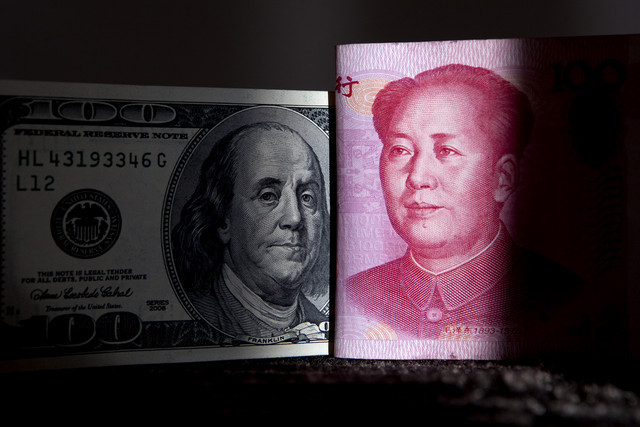 |
The yuan climbed 0.2 percent in November to 6.2267 per dollar in Shanghai and on Nov. 27 reached the highest level since China unified official and market exchange rates in 1993. (Bloomberg) |
China may maintain its annual economic growth target at 7.5 percent next year in a sign the new leadership headed by Xi Jinping won’t tolerate a bigger slowdown from the lowest goal since 2004.
Nine of 16 analysts surveyed over the last two weeks by Bloomberg News forecast the government will set a goal unchanged from 2012, while six expect a decline to 7 percent and one sees an increase to 8 percent. Top economic officials meet this month to map out policies for 2013 and may set the target that will be officially announced in March at the annual session of parliament.
A goal of 7.5 percent would signal that Xi and Li Keqiang, set to succeed Wen Jiabao as premier, are prepared to expand fiscal and monetary easing should China’s nascent economic recovery falter. A manufacturing gauge rose to a seven-month high in November, data released Dec. 1 showed, adding to evidence growth is rebounding from a three-year low.
“This will send a clear message from the new leadership that they want to ensure stable economic growth,” said Li Miaoxian, a Beijing-based economist with Bocom International Holdings Co., the investment banking unit of Bank of Communications Co. “Seven percent would be too low because it will make the market worry.”
Li forecast a target of 7.5 percent, which he said would probably lead to actual growth higher than 8 percent and allow the government to be “more accommodative” in its economic policies than it could with a 7 percent goal.
Economic Recovery
The increase in November’s official manufacturing Purchasing Managers’ Index to 50.6 underscores optimism the economy is recovering after a seven-quarter slowdown. A gauge of new orders rose to its highest level since April and the output reading was the highest in six months, according to the report from the National Bureau of Statistics and China Federation of Logistics and Purchasing.
Baoshan Iron & Steel Co., the nation’s biggest publicly traded mill, said Nov. 12 that it would raise prices for most cold-rolled products for December delivery, the first increase for three months.
A separate manufacturing index from HSBC Holdings Plc (HSBA) and Markit Economics, which focuses on smaller businesses, will be released today. Its preliminary November reading showed the first expansion in 13 months. The federation will also today release its services PMI for November.
Yuan Strengthens
The yuan had its fourth monthly gain, its longest winning streak in more than a year, on signs economic growth is recovering. The currency climbed 0.2 percent in November to 6.2267 per dollar in Shanghai and on Nov. 27 reached the highest level since China unified official and market exchange rates in 1993.
China’s gross domestic product may expand 7.7 percent in the fourth quarter from a year earlier, the first acceleration in eight quarters, according to the median estimate of 29 analysts in a Bloomberg survey. Growth was 7.4 percent in the three months through September.
Premier Wen set a target for annual average expansion of 7 percent in the nation’s five-year plan from 2011 to 2015 to create a more sustainable economy focused on consumption, shifting away from investment and export-dependent growth that led to environmental degradation, rising inequality and manufacturing overcapacity.
Wen set a 2012 goal of 7.5 percent, the lowest since 2004. Yet the deterioration in the economy in the second and third quarters raised the risk he would miss the target for the first time since taking office in 2003.
Five-Year Goal
The median estimate for 2012 growth in Bloomberg’s November survey of economists was 7.7 percent, down from 8 percent in August, while the pace for next year will pick up to 8.1 percent, compared with August’s median of 8.4 percent. The economy expanded at an annual average pace of 10.6 percent in the decade through 2011.
Citigroup Inc. and JPMorgan Chase & Co. estimate Wen, in his final work report to parliament, will announce a 2013 target of 7 percent.
That pace would bring the government closer to its five- year plan goal, said Zhu Haibin, chief China economist at JPMorgan in Hong Kong.
“It will be a clear signal to the local governments that the new Chinese leaders want more quality in growth instead of just a high growth rate,” Zhu said. “The official growth target is always taken as the minimum by local governments,” so 7.5 percent may encourage some “to blindly expand investment.”
Power Transfer
At the same time, shifting growth away from investment may slow expansion to a pace the Communist Party would be reluctant to tolerate, according to Citigroup analysts.
Last month’s party congress that anointed a new generation of leaders set an objective of doubling 2010 GDP and per capita income by 2020, implying annual average growth of 7 percent, Citigroup economists in Hong Kong led by Ding Shuang wrote in a Nov. 27 report.
That indicates “a minimum rate of growth needs to be achieved,” they said. “The new leaders may not see it as an option to implement big bang reforms that promise to unleash long-term potential but sacrifice growth significantly” in the short run. (Bloomberg)





![[Exclusive] Hyundai Mobis eyes closer ties with BYD](http://res.heraldm.com/phpwas/restmb_idxmake.php?idx=644&simg=/content/image/2024/11/25/20241125050044_0.jpg)

![[Herald Review] 'Gangnam B-Side' combines social realism with masterful suspense, performance](http://res.heraldm.com/phpwas/restmb_idxmake.php?idx=644&simg=/content/image/2024/11/25/20241125050072_0.jpg)
